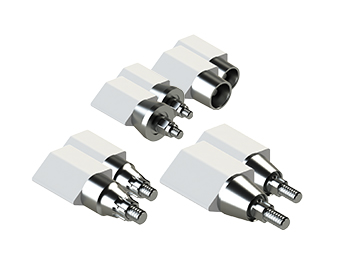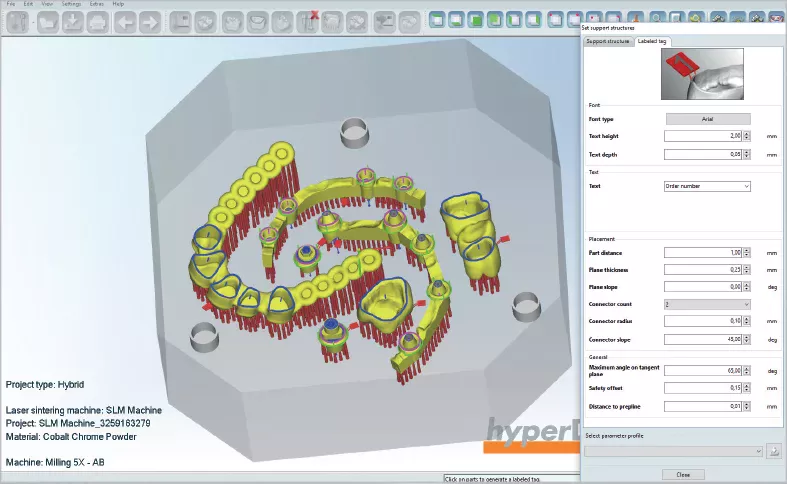

hyperDENT® is the world leading software system in the dental CAM market and is valued among experts for its modular product structure. Our customers are provided with CAM solutions tailored to their specific application and implementation needs. Regardless of company size and whether for dental or practice labs, FOLLOW-ME! offers suitable hyperDENT® product bundles for a perfect interaction between CAM and machines.
Read more

hyperDent Practicelab is geared to the needs of practice labs and is optimally suited for CAM newcomers. The user interface is highly automated, which facilitates handling significantly. The managed workflow and minimized range of functions enable the user to calculate tool paths for individual blanks, such as glass ceramic blocks and preform abutments, in just a few steps and send them to the machine for milling.
The ideal blank is recognized already during the automatic loading process and suggested to the user. The positioning of the blank and setting of the connector are also automated. For machines with multiple slots, multiple blanks can be loaded and calculated within a project, saving the user valuable time. Predefined milling strategies ensure high process stability and efficiency.



hyperDent Compact was designed for use in dental labs and can be utilized on all open milling machines. The simplified user interface with a managed workflow provides real added value for high-end newcomers and those who wish to become quickly familiar with CAM. Provided databases allow fast, secure, efficient and precise milling. With the exception of one-piece abutments and bridge constructions, all indications can be manufactured using hyperDENT® Compact. Within no time, users will achieve optimal results to match their requirements.
Please note: Not all modules available in hyperDENT® Classic can be utilized with hyperDENT® Compact. An upgrade to hyperDENT® Classic is possible at any time.

hyperDent Classic was developed for the advanced user. This open CAM solution is No. 1 amongst milling centers where flexible and optimized manufacturing processes are crucial. However, dental labs can also benefit from the advantages of hyperDENT® Classic. Once the user becomes familiar with the software, all possibilities are open utilizing the various hyperDENT® Options (modules). The simultaneous processing and calculation of multiple projects using the Multiple Start function is very intuitive and a huge timesaver. With the Template Generator, the user can develop individual milling strategies. These tailor-made solutions meet challenging market requirements precisely, resulting in higher customer satisfaction. With the provided interfaces to machine automations, more efficient machining is achieved and blanks can be processed with ease. In addition, the Implant Module enables machining of one-piece abutments and bridge constructions. hyperDENT® Classic’s professional functionality and variety of complementary options deliver high performance to demanding users.


The hyperDENT® Denture Module enables digital manufacturing of full dentures with a significantly reduced processing time compared to the analog process. hyperDENT® is one of the first CAM software systems to provide a specified and automated tool paths for this indication type. With the Denture Module, you can produce different workflow variations such as fully completed rows of teeth or pre-milled tooth pockets. Interfaces to diverse CAD systems are available and guarantee easy handling.

With the hyperDENT® Implant Module, customized abutments, implant bridges and bars can be manufactured from circular blanks. Due to intelligent categorization, only one master template is required for all systems. This module can also be combined with a millable interface geometry library for the most commonly-used implant systems. This library can be linked to a corresponding CAD dummy geometry library. It is easy to implement your own geometries as well. Despite possible inaccuracies in upstream systems, an automated exchange mechanism for geometries ensures that high precision parts are manufactured.

hyperDENT® enables simple and easy grinding of glass ceramic using special strategies for the optimal generation of tool paths. Where possible, the full tool circumference and length is used to extend tool life and guarantee high process stability. hyperDENT® Grinding Module enables grinding of glass ceramic, lithium disilicate and other materials. with special, tool- protective cycles optimized for grinding.

The hyperDENT® Implant Components are the matching hardware for the hyperDENT® Implant Module. The scanbodies are very easy to handle and are compatible with all widely-used lab scanners. They enable highly precise, industrial manufacturing (milling and hybrid manufacturing) within a very narrow tolerance range. This is due to the optimal design of the components which guarantees simple recognition of the position and exact alignment of the implant. This high precision makes our scanbodies perfectly suitable for scanning implant bridges. A wide range of implant libraries and a univeral screwdriver complement our professional implantology offering.

The hyperDENT® Template Generator Module enables you to create customized machining templates for all part types which can then be tested using material removal simulation. Thanks to the simple and intuitive user interface, an experienced CAM user can immediately begin creating and modifying machining templates (i.e. cutting data, tools, milling strategies).

hyperDENT® Classic can be started multiple times in order to work on multiple projects simultaneously. While one or multiple projects are calculating, additional projects can be prepared. This results in high CAM workstation utilization.

Operates any number of machines and/or machine types with a single hyperDENT® license.

The hyperDENT® Hybrid Module enables the combination of additive and subtractive technologies in one workflow. Complex geometries, inner cavities and previously non-millable dental indications can be manufactured in high quantities with very high surface quality while using minimal material. Automated workflows, such as optimal nesting of the parts on the building platform, creating support structures or generating part-offsets in the areas to be post-milled, round off this all-in-one solution.